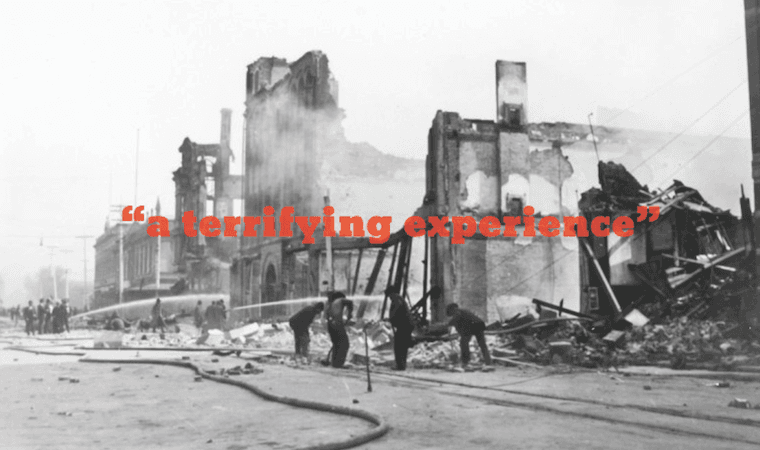New research backs up historical narratives about two earthquakes in the 68 years before San Francisco’s devastating 1906 disaster.
The geologic evidence places the two earthquakes, in 1838 and 1890, on the San Andreas Fault, as theorized by many researchers based on written accounts about damage to Spanish-built missions in the Monterey and San Francisco bay areas. These two quakes, as in 1906, were surface-rupturing events, the researchers conclude.
Continuing work, says University of Oregon doctoral student Ashley R. Streig, will dig deeper into the region’s geological record—layers of sediment along the fault—to determine if the ensuing seismically quiet years make up a normal pattern—or not—of quake frequency along the fault.
Streig is lead author of the study, published in this month’s issue of the Bulletin of the Seismological Society of America. She collaborated on the project with Ray Weldon, professor in the department of geological sciences, and Timothy E. Dawson of the California Geological Survey.
The study was the first to fully map the active fault trace in the Santa Cruz Mountains using a combination of on-the-ground observations and airborne Light Detection and Ranging (LiDAR), a remote sensing technology.
The Santa Cruz Mountains run for about 39 miles from south of San Francisco to near San Juan Batista. Hazel Dell is east of Santa Cruz and north of Watsonville.
“We found the first geologic evidence of surface rupture by what looks like the 1838 and 1890 earthquakes, as well as 1906,” says Streig.
Unlike the 1906 quake that ruptured 296 miles of the fault, the 1838 and 1890 quakes ruptured shorter portions of the fault, possibly limited to the Santa Cruz Mountains. “This is the first time we have had good, clear geologic evidence of these historic 19th century earthquakes,” she says. “It’s important because it tells us that we had three surface ruptures, really closely spaced in time that all had fairly large displacements of at least half a meter and probably larger.”
Wood Chips and Charcoal
The team identified ax-cut wood chips, tree stumps, and charcoal fragments from early logging efforts in unexpectedly deep layers of sediment, five feet below the ground, and document evidence of three earthquakes since logging occurred at the site. The logging story emerged from 16 trenches dug in 2008, 2010, and 2011 along the fault at the Hazel Dell site in the mountain range.
High-resolution radiocarbon dating of tree-rings from the wood chips and charcoal confirm these are post-European deposits, and the geologic earthquake evidence coincides with written accounts describing local earthquake damage, including damage to Spanish missions in 1838, and in a USGS publication of earthquakes in 1890 catalogued by an astronomer from Lick Observatory.
Additionally, in 1906 individuals living near the Hazel Dell site reported to geologists that cracks from the 1906 earthquake had occurred just where they had 16 years earlier, in 1890, which, Streig and colleagues say, was probably centered in the Hazel Dell region. Another displacement of sediment at the Hazel Dell site matched the timeline of the 1906 quake.
The project also allowed the team to conclude that another historically reported quake, in 1865, was not surface rupturing, but it was probably deep and, like the 1989 event, occurred on a sub zone of the San Andreas Fault. Conventional thinking, Streig says, has suggested that the San Andreas Fault always ruptures in a long-reaching fashion similar to the 1906 earthquake. This study, however, points to more regionally confined ruptures as well.
“This all tells us that there are more frequent surface-rupturing earthquakes on this section of the fault than have been previously identified, certainly in the historic period,” Streig says. “This becomes important to earthquake models because it is saying something about the connectivity of all these fault sections—and how they might link up.”
Three Times in 100 Years
The frequency of the quakes in the Santa Cruz Mountains, she adds, must have been a terrifying experience for settlers during the 68-year period.
“This study is the first to show three historic ruptures on the San Andreas Fault outside the special case of Parkfield,” Weldon says, referring to a region in mountains to the south of the Santa Cruz range where six magnitude 6-plus earthquakes occurred between 1857 and 1966.
“The earthquakes of 1838 and 1890 were known to be somewhere nearby from shaking, but now we know the San Andreas Fault ruptured three times on the same piece of the fault in less than 100 years.”
The US Geological Survey funded the research. A Geological Society of America Student Research Grant to Streig funded the age-dating of the team’s evidence at the Lawrence Livermore National Laboratory’s Center for Accelerator Mass Spectrometry.
Source: University of Oregon
Republished from Futurity.org under Creative Commons license 3.0.




